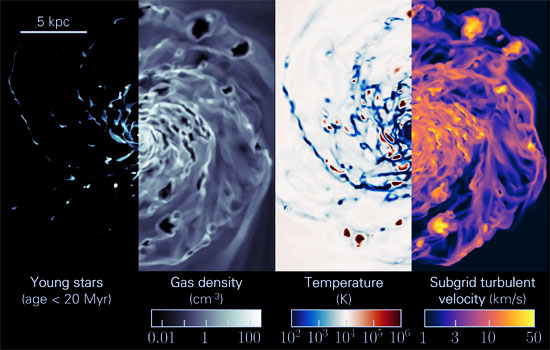 |
 |
 |
 |
 |
 |
 |
 |
 |
 |
 |
 |
|
Talks & Events
|
Ph.D. Thesis Defenses: 2019
How Galaxies Form Stars: the Connection between Local and Global Star Formation in Galaxies Ph.D. Committee members: Andrey V. Kravtsov, Nickolay Y. Gnedin, Damiano Caprioli, Richard G. Kron Thesis Abstract: The fact that observed star-forming galaxies convert their gas into stars inefficiently is a long-standing theoretical puzzle. Available gas in galaxies is depleted on a timescale of several Gyrs which is orders of magnitude longer than any timescale of the processes driving gas evolution in galaxies. Many galaxy simulations can reproduce observed long depletion times but the physical mechanism controlling their values is not well understood. In addition, some of the simulations show a rather counter-intuitive behavior: global depletion times appear to be almost insensitive to the assumptions about local star formation in individual star-forming regions, a phenomenon described as "self-regulation." Yet another part of the puzzle is the observed tight and near-linear correlation between star formation rates and the amount of molecular gas on kiloparsec and larger scales. A linear correlation implies that the depletion time of molecular gas is almost independent of molecular gas density on >kiloparsec scales, while a strong dependence is expected if, e.g., star formation is controlled by molecular gas self-gravity. I will present results from a suite of isolated disk galaxy simulations in which we systematically explored the behavior of depletion times. Using insights from these simulations we formulated an intuitive physical model that explains both the origin of long gas depletion times in observed galaxies and the results of galaxy formation simulations. This model and our simulation results also provide major insights into the origin of the observed linear correlation between star formation rates and molecular gas. Multi-Pronged Studies of Diffuse Halo Gas around Massive Quiescent Galaxies Ph.D. Committee members: Hsiao-Wen Chen, Wendy Freedman, Nick Gnedin, Rich Kron. "Fakhri's ground breaking research addresses long-standing puzzles concerning the formation and growth of massive galaxies. During his graduate study, Fakhri led multiple innovative and ambitious observing programs to characterize the diffuse gas content in and around distant galaxies. His thesis work casts critical new insights into the chemical enrichment in quiescent halo. Fakhri is on a great trajectory and will continue his outstanding research at Carnegie Observatories as a Carnegie fellow in the fall. - Hsiao-Wen Chen, Ph.D. advisor Thesis Abstract: While significant progress has been made in understanding various aspects of galaxy evolution in the last few decades, a self-consistent explanation for the diffuse gaseous halos (also known as the circumgalactic medium; CGM) surrounding galaxies still eludes us. Particularly puzzling is the high incidence of cool gas in the gaseous halos of massive quiescent galaxies, which is at odds with their lack of star-formation activity and the theoretical expectation that their diffuse baryons are predominantly hot. Characterizing the physical properties of the gaseous halos of massive quiescent galaxies is necessary to build an empirical understanding of the co-evolution of galaxies and gas over cosmic time. In my thesis talk, I will present a series of observational studies that investigate the gaseous halos of intermediate-redshift (z~0.5) massive elliptical galaxies, using precision analysis of quasar absorption-line spectroscopy. I will demonstrate what the elemental abundances and abundance patterns, kinematics, and ionization states of the gas tell us about the complex baryonic processes taking place on large (~100 kpc) and small (<10 kpc) scales in the halos of these "red and dead" galaxies. The results of my work shed light on the origin and fate of the cool gas around massive ellipticals, as well as feedback mechanisms responsible for preventing star-formation in massive halos. |


